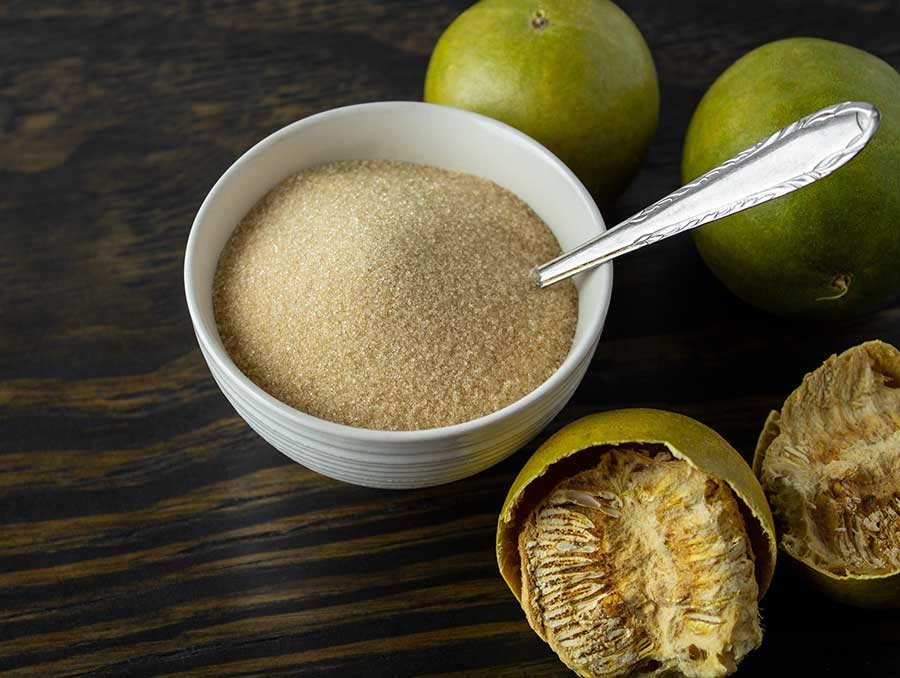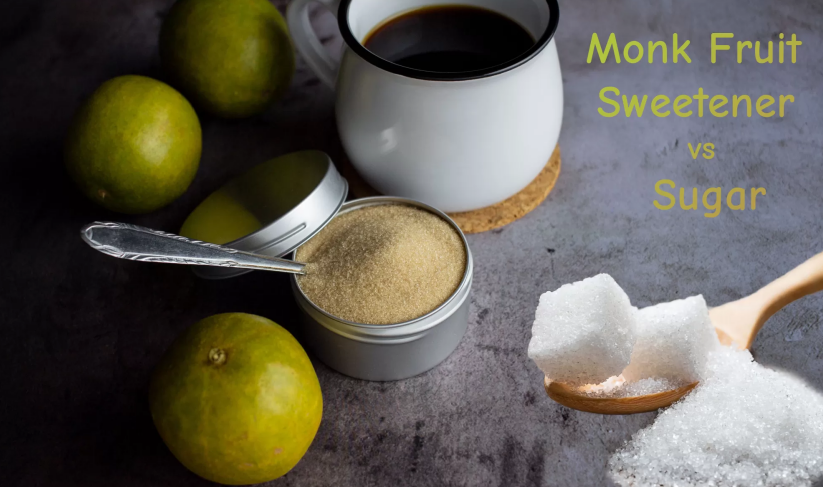Monk Fruit Extract Benefits are reshaping how brands cut sugar while keeping taste. At B-Thriving, we manufacture monk fruit extract for formulators who need dependable sweetness with a clean, consumer-friendly story. Monk fruit is rich in mogrosides; notably, mogroside V delivers 100-250x the sweetness of sucrose yet is virtually calorie-free. It supports insulin response without raising blood sugar and provides antioxidant activity that helps reduce free-radical damage. That is why our partners use it across foods, beverages, dietary supplements, sports formulas, and even cosmetics.

The Science Value of Monk Fruit Extract
For product teams, monk fruit extract means high sweetness at very low use levels. This unlocks clear sugar reduction and leaner nutrition panels without artificial additives. Because monk fruit doesn’t raise blood sugar, it aligns with diabetic-friendly diets and modern low-sugar positioning. Antioxidant properties add another layer of value for wellness-oriented launches and premium line extensions.
As a manufacturer, we focus on repeatable quality. Consistency matters when your SKU family scales across formats and flavors. Our monk fruit extract is designed to integrate into ready-to-drink beverages, functional powders, bars, gummies, and personal-care concepts that benefit from a naturally sweet profile.
•B-Thriving Technical Snapshot
- Part Used: Fruit
- Active Ingredient: Mogroside IV 5-50%
- Test Method: HPLC (High Performance Liquid Chromatography)
- Appearance: Yellow or off-white fine powder
- Sweetness Potency: Mogroside V is ~100-250x sweeter than sucrose
- Calorie Profile: Practically zero-calorie substitute
- Metabolic Support: Improves insulin sensitivity; does not raise blood sugar
- Antioxidants: Helps reduce free-radical damage
- Primary Applications: Food, beverages, dietary supplements, cosmetics
•Formulation Notes for Product Teams
When you target deep sugar cuts, potency matters. Monk fruit’s high intensity enables meaningful reductions without adding significant bulk. It supports metabolic health claims within your regulated markets and messaging frameworks. In sports nutrition, it fits pre-workout and post-workout blends as a natural zero-calorie sweetener for sports nutrition, contributing sweetness without adding calories that can work against physique or performance goals. For daily wellness products, it helps you deliver a pleasant taste with a straightforward ingredient line.
Monk Fruit Extract Benefits vs. Other Natural Sweeteners
Natural sweeteners each bring trade-offs. Many contribute calories or have different metabolic effects. Monk Fruit Extract Benefits stand out because sweetness is intense while calorie impact is negligible. That helps brands hit sugar-reduction targets without compromising nutrition facts. It also supports positioning for consumers who monitor blood sugar.
From a brand strategy perspective, monk fruit extract offers a compelling value stack: potent sweetness, virtually no calories, and antioxidant support. This combination lends itself to premium products where every functional attribute must justify shelf price and loyalty. Because the sweetness is derived from mogrosides in the fruit, you gain a simple, nature-forward story that resonates in clean-label marketing and best sugar substitute for diabetic-friendly diets content.
In innovation pipelines, monk fruit extract also reduces complexity. One ingredient can serve multiple categories – hydration drinks, vitamin chews, meal-replacement mixes, and even beauty-from-within lines – so your procurement and quality teams manage fewer variables while maintaining consistent sweetness targets.
* Below is a systematic comparison of Other Natural Sweeteners by key parameters, to serve as a reference for positioning and selecting relative to Monk Fruit. The figures reflect common industry ranges and will vary based on raw material source, purity, and formulation environment.
Quick Comparison Table (Sucrose = 1 baseline)
| Sweetener | Relative Sweetness* | Calories (kcal/g) | Glycemic Impact / GI | Taste & Aftertaste | Key Advantages | Key Considerations | Typical Applications |
| Stevia (Steviol Glycosides) | 200–300 | ~0 | GI≈0, does not raise blood sugar | Slight herbal/licorice aftertaste | High-intensity, heat-stable, clean label | Bitterness at high dose; often needs masking or blending with polyols | Beverages, baking, meal replacements |
| Erythritol | 0.6–0.7 | ≈0 (~0.2) | GI≈0 | Cooling effect, sugar-like body | Tooth-friendly, heat-stable, good crystallization | GI discomfort at high intake; manage crystallization | Chocolate, baking, beverages |
| Xylitol | 1.0 | 2.4 | Low (≈7–13) | Clean sweetness | Oral-health benefits, sugar-like | Toxic to dogs; laxative risk if overused | Gum, lozenges, baking |
| Allulose | 0.7 | 0.2–0.4 | GI≈0 | Sugar-like body; good browning | Low calorie; helpful for freezing point control | GI discomfort at high intake; regulatory variations | Ice cream, syrups, baking |
| Honey | 1.0–1.2 | ~3–4 | Medium (≈45–64) | Complex flavor, lingering aroma | Natural image; trace antioxidants | Not for infants; high in sugars | Tea, dressings, baking glaze |
| Agave Syrup | 1.1–1.4 | ~3–4 | Low (≈15–30), high fructose | Smooth mouthfeel | Dissolves easily, gentle taste | High fructose load; hepatic metabolism burden | Cold drinks, cocktails, baking |
| Coconut Sugar | 0.9–1.0 | 4 | Medium–low (≈35–54) | Caramel notes | Small amounts of minerals/inulin | GI not very low; sustainability concerns | Coffee, baking, sauces |
| Maple Syrup | 1.0–1.1 | ~3–4 | Medium (≈54) | Distinct maple flavor | Trace Mn/Zn | High sugar; higher cost | Breakfast syrups, baking, desserts |
| Molasses | 0.6–0.7 | 4 | Medium (≈55) | Strong flavor; dark color | Relatively mineral-rich | Heavy flavor; deep color | Dark bakes, sauces |
| Date Syrup/Paste | 0.8–1.0 | 4 | Medium–low (≈43–55) | Pronounced date flavor | Polyphenols & fiber (form-dependent) | Powder form dissolves poorly; dark color | Energy bars, baking |
| Yacon Syrup | 0.3–0.5 | 1–2 | Very low (rich in FOS) | Light fruity note | Prebiotic properties | Gas/bloating risk; modest heat stability | Cold use, yogurt |
| Brown Rice Syrup | 0.5–0.7 | 4 | High (≈85–98) | Mild malty note | Low allergenicity; good texture/binding | High GI; arsenic concerns in raw materials | Energy bars, baking |
*Relative sweetness uses sucrose = 1 as baseline; actual performance depends on matrix, temperature, and acidity.
Selection Keys & Formulation Tips
•Sugar control & mouthfeel balance: When you need sugar-like body and bulk, start with allulose + erythritol, then fine-tune peak sweetness and aftertaste with a small dose of a high-intensity sweetener (stevia or monk fruit).
•Low-GI / metabolic friendly: Erythritol, allulose, and stevia are most supportive for blood-sugar management. Xylitol is low-GI but requires strict pet safety controls.
•Flavor building: For flavor-led products (coffee, baking, sauces), consider coconut sugar / maple syrup / molasses / date sweeteners – accepting color and flavor impact as part of the profile.
• Regulatory & labeling: Markets differ on “low/no sugar” claims, energy accounting (e.g., allulose), and whether ingredients count toward total/added sugars. Verify before launch.
* Quick Takeaways vs. Monk Fruit
•Intensity & calories: Monk fruit is high-intensity and near zero-calorie; most in the table are “bulk” or medium-intensity with higher calories and GI.
•Aftertaste & blends: Like stevia, monk fruit can have a detectable aftertaste; it’s often blended with erythritol/allulose to improve taste and provide bulk.
•Application flexibility: For ultra-low dosage and deep sugar cuts, monk fruit (often with polyols) reaches targets efficiently. When you need a flavor role (caramel, maple, molasses), syrup-type sweeteners are better building blocks.
• Evaluation tip: Define targets (reduction level, mouthfeel, cost, allowable claims). Build 2-3 lab samples using the bulk sweetener + high-intensity sweetener approach, then run quick blind sensory to select the winning combination.

Applications and Partnership with B-Thriving
B-Thriving supports both R&D sprints and global rollouts. Our HPLC-verified specifications help your QA teams approve faster and your co-manufacturers scale with confidence. Whether you are launching a new beverage, reformulating a flagship snack, or adding sweetness to a topical cosmetic, Monk Fruit Extract Benefits align with modern consumer expectations for taste and health.
Where brands use it today:
•Food: Low-sugar bars, baked goods, confectionery alternatives
•Beverages: Functional waters, teas, energy drinks, smoothies
•Dietary Supplements: Gummies, tablets, multivitamin powders, meal replacements
•Sports Nutrition: Pre-workout, intra-workout, and recovery formulas needing sweetness without extra calories
Our process is collaborative. We begin with your sugar-reduction target and sensory brief. We supply samples, COAs, and guidance on potency ranges aligned to your matrix. Because monk fruit extract is potent, small adjustments go a long way. That precision helps your team keep flavor systems balanced while protecting nutrition goals and cost-in-use.
CTA – Build Your Low-Sugar Portfolio with B-Thriving
Ready to compare monk fruit head-to-head in your next pilot run? Contact B-Thriving for samples, HPLC-verified specs, and pricing options. Let’s translate Monk Fruit Extract Benefits into consumer-loved products across your lineup – and help your brand lead the low-sugar era.
